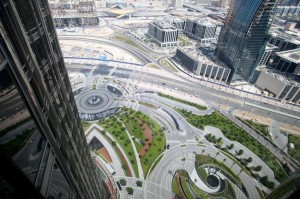By Angela Shah www.nytimes.com
DUBAI — For the clients of the investment adviser Manoj Prasad, “distressed property” in this Gulf emirate has an unlikely new address: the world’s tallest tower.

“They have money and want a place here to entertain clients and guests, and have a holiday home for when they transit through,” Mr. Prasad said — but they also want reduced prices for their piece of the 828-meter, or 2,717-foot, tower. “They are definitely viewing this as a distressed property.”
How the Burj Khalifa, among the world’s most luxurious properties, can be considered distressed helps to illustrate the extent of the downturn in Dubai’s real estate market in recent years.
Two years ago, the tower held a glitzy, fireworks-themed grand opening that attracted worldwide news coverage. But by October 2010 apartment prices at the Burj Khalifa had dropped 40 percent and they have yet to recover.
In fact, the city center of Dubai, which includes the Burj Khalifa, was one of two neighborhoods that experienced declines of 11 percent in apartment prices in December 2011 compared with the previous year, according to the real estate agency Jones Lang LaSalle. That was the largest drop in the emirate.
Five years ago, Anil Gehani, an Indian, bought two Khalifa units before construction began, a one-bedroom and a two-bedroom. Initially, he watched the value leap from 2,200 dirhams, or $599, per square foot — equivalent to $6,440 per square meter — to 7,000 dirhams per square foot in 2008.
Then, as the worst of the real estate crisis gripped Dubai’s market in 2009, values “came down really bad,” well below his purchase price, he said.
Three months ago, deciding that he had had enough, he sold both units. “It didn’t appreciate very much,” he said. “I made some small profit and got out. I thought I would move the money into a better investment in India.”
Similarly, Imad Ben Khadra, a Moroccan expatriate, paid 3.5 million dirhams for two one-bedroom units on the tower’s 21st and 22nd floors in late 2008.
Six months ago, after more than a year of trying to find long-term renters, he sold them for about a third less than he paid.
Yet even though the Burj Khalifa values have dropped, real estate analysts say they believe it is one of a handful of local projects where prices have stabilized. Currently, real estate agents say the average price per square foot for tower apartments is around 2,200 dirhams.
In the city center, prices have fallen about 40 percent since their peak in late 2008, according to Craig Plumb, head of research for Jones Lang LaSalle’s Middle East and North Africa consulting business. Values have dropped 60 percent for the city over all, where the average price per square foot is now around 890 dirhams, and even more in developments further into the desert, away from Dubai’s main business towers and beaches.
Continued devaluation of many apartment projects is expected this year, especially as an additional 25,000 units are expected to be completed and come on the market in 2012. There are already 340,000 apartments and villas in the emirate.
A year ago, crises in Egypt and Bahrain briefly gave a boost to Dubai’s beleaguered real estate market, as executives and their families sought a more secure post in the Middle East. But as the year ended, the problems resurfaced and there were few significant sales in the Dubai market during the second half of 2011, according to Jones Lang LaSalle.
Sales were not helped by headlines like those about Nakheel, the developer of the Palm Jumeirah development, which has been in dispute with owners and tenants over what it says are unpaid service fees. The developer has restricted residents’ access to the beach, pool and even parking garages. In response, residents recently called the police to complain about safety hazards related to the closing of the back doors on 10 apartment buildings overlooking the beach. More info












